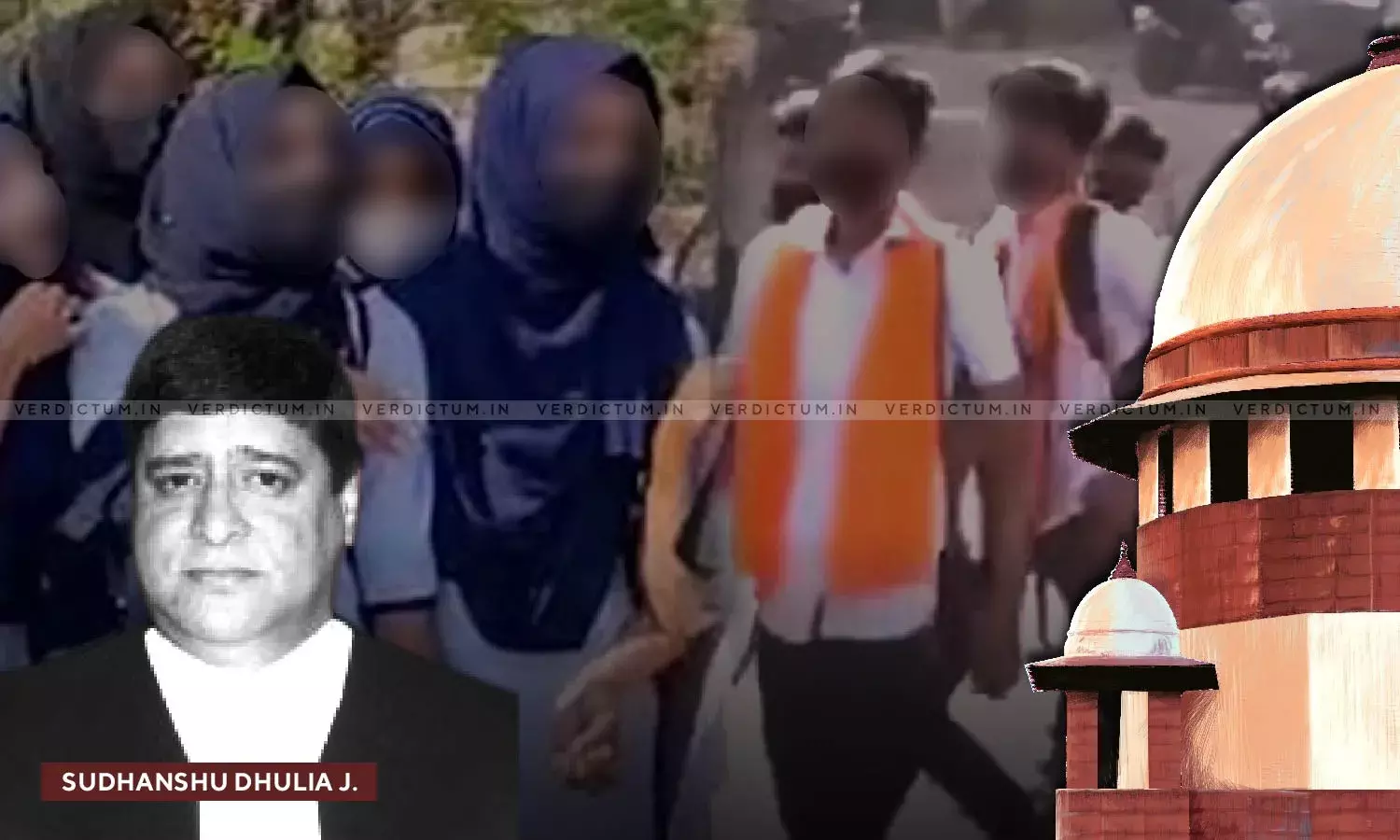Hijab Is A Choice, Family Won't Let Her Go To School Without Hijab: Contradictory Findings In Justice Dhulia's Opinion

Is the wearing of hijab a matter of exercise of free choice or are the young girls compelled or pressurised to wear it? It is both, as per the opinion of Justice Sudhanshu Dhulia in the split verdict delivered by the Supreme Court.
Justice Dhulia has held that asking the girls to take off their hijab before they enter the school gates is clearly violative of the right to freedom of expression under Article 19(1)(a) of the Constitution.
"Under our Constitutional scheme, wearing a hijab should be simply a matter of Choice. It may or may not be a matter of essential religious practice, but it still is, a matter of conscience, belief, and expression", the Judge held.
The Judge then held that "If she wants to wear hijab, even inside her classroom, she cannot be stopped, if it is worn as a matter of her choice, as it may be the only way her conservative family will permit her to go to school, and in those cases, her hijab is her ticket to education" (emphasis supplied). In the same sentence the Judge says that wearing could be a matter of choice of the child when her "conservative family" may be forcing her to wear hijab as a precondition for going to school.
Justice Dhulia also holds that the "unfortunate fallout of the hijab restriction would be that we would have denied education to a girl child". Justice Dhulia says that it is not easy for a girl child to reach her school gate and the issue should be seen from the perspective of the challenges already faced by a girl child in reaching her school.
The Judge even says that the girls will land in madrasas since they were forced to seek transfer on account of the ban on hijab.
Pressure to wear Hijab
Hijab is an expression of patriarchal oppression of women. The requirement to wear hijab has to be seen along with other patriarchal diktats in religious texts, like the requirement for women should lower their gaze before men and the restriction on women travelling alone, without the company of a male relative. In fact, one such diktat was discussed during the hearing before the Supreme Court.
"Na Muh Chhupa Ke Jiyo, Na Sar Jhuka Ke Jiyo, Agar Gham Ke Daur Aaye To, Muskura Ke Jiyo", the Karnataka AG had concluded his arguments before the High Court with this line from a Bollywood song.
During the hearing before the Apex Court, the Solicitor General referred to what is happening in Iran and other Islamic countries, where women are risking their lives to come out and protest against compulsion by the theocratic states to wear hijab.
During the hearing before the High Court, Senior Advocate Sajan Poovayya had asked why we are teaching only our girl child to dress modestly and not boys. "I will not prescribe a protective attire to a girl child non-protective attire to a boy child on the basis of a religious faith that says that a girl must be dressed modestly and a boy need not", he had argued.
Senior Advocate A.M. Dhar, who also appeared before the Apex Court for the Appellants had argued before the High Court that hijab is prescribed by religion to protect the modesty and chastity of girls so that there is no attraction to "vulnerable parts" of the body.
Compelled by family to exercise free choice?
Justice Dhulia has acknowledged in his opinion that a girl child is already facing challenges to reach the school. The Judge says that the Court was informed that as a fallout of the enforcement of hijab ban in schools, some of the girl students were not able to appear in their Board examinations and many others were forced to seek transfer to other schools, most likely madrasas, where they may not get the same standard of education. "This is for a girl child, for whom it was never easy, in the first place, to reach her school gate", the judgment says.
Justice Dhulia also says that in villages, it is commonplace for a girl child to help her mother in her daily chores of cleaning and washing before she can grab her school bag. "The hurdles and hardships a girl child undergoes in gaining education are many times more than a male child. This case therefore has also to be seen in the perspective of the challenges already faced by a girl child in reaching her school. The question this Court would therefore put before itself is also whether we are making the life of a girl child any better by denying her education, merely because she wears a hijab!", the Judge says.
Despite accepting the ground reality of families compelling girls to wear hijab, Justice Dhulia holds that hijab is an expression of free choice. To justify practices like hijab in the name of helping girls to reach school is to lend support to the patriarchal mindset of "conservative families" and encourage them to further oppress girl children. At least, that justification should not have been in the name of Article 19(1)(a).
[The opinions expressed in this article are those of the author. Verdictum does not assume any responsibility or liability for the contents of the article.]

